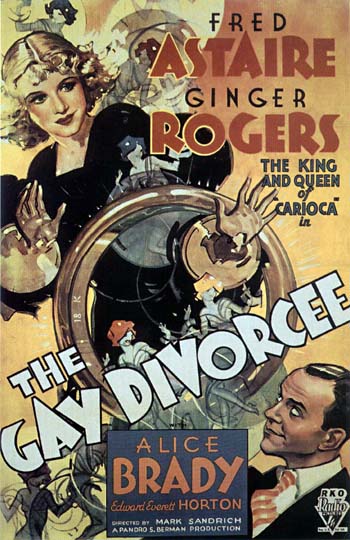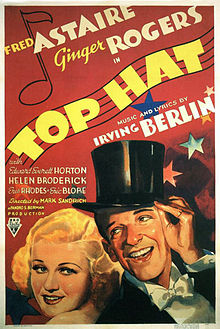(Lisa is currently in the process of trying to clean out her DVR by watching and reviewing all 40 of the movies that she recorded from the start of March to the end of June. She’s trying to get it all done by the end of July 11th! Will she make it!? Keep visiting the site to find out!)
The 31st film on my DVR was the 1934 musical, The Gay Divorcee, which I recorded on June 7th when it aired on TCM.
The Gay Divorcee is a Fred Astaire/Ginger Rogers musical, which means that the plot is less important than the dancing, the singing, and the charm. The charm is especially important. Don’t get me wrong — The Gay Divorcee includes some wonderful music, including Night and Day and The Continental, which went on to be the first song to win an Oscar for Best Original Song. The dancing is incredible, as you would expect from any film featuring Astaire and Rogers.
But it’s the charm that makes The Gay Divorcee especially memorable. Full of sophisticated dialogue delivered by a cast of wonderful 1930s character actors, The Gay Divorcee offered up an escape to a country that was still reeling from the Great Depression. Some audiences went to a Warner Bros. gangster film and some audiences went to an Astaire/Rogers musical but what they all had in common was that the movies provided them a break from the harsh realities and hopelessness of everyday life.
As for the plot — well, it’s about rich people doing silly things. Mimi Glossop (Ginger Rogers) wants to get a divorce from her husband, a gynecologist named Cyril (William Austin). Apparently, Cyril doesn’t want to give her a divorce so Mimi, her aunt (Alice Brady), and her lawyer (Edward Everett Horton) come up with a plan that could only work in an Astaire/Rogers musical. Mimi will visit England and, while staying at a properly luxurious hotel, she will pretend to have an affair with Rodolfo Tonetti (Erik Rohodes), a professional gigolo.
However, upon arriving at the hotel, Mimi runs into Guy Holden (Fred Astaire). Guy is a friend of Rodolfo’s and he also happens to be in love with Mimi. Mimi, meanwhile, mistakes Guy for the gigolo and they proceed to dance the night away…
Listen, the plot doesn’t matter! What matters is that The Gay Divorcee features Fred Astaire and Ginger Rogers at their best! This, after all, is the film that features Fred Astaire singing Cole Porter’s Night and Day…
And, of course, there’s The Continental…
The Gay Divorcee was one of the ten films nominated for best picture of 1934. However, it lost to an equally charming film of the 1930s, It Happened One Night.
The Gay Divorcee was a fun and needed escape for viewers in the 30s and you know what? We still need an escape today.

